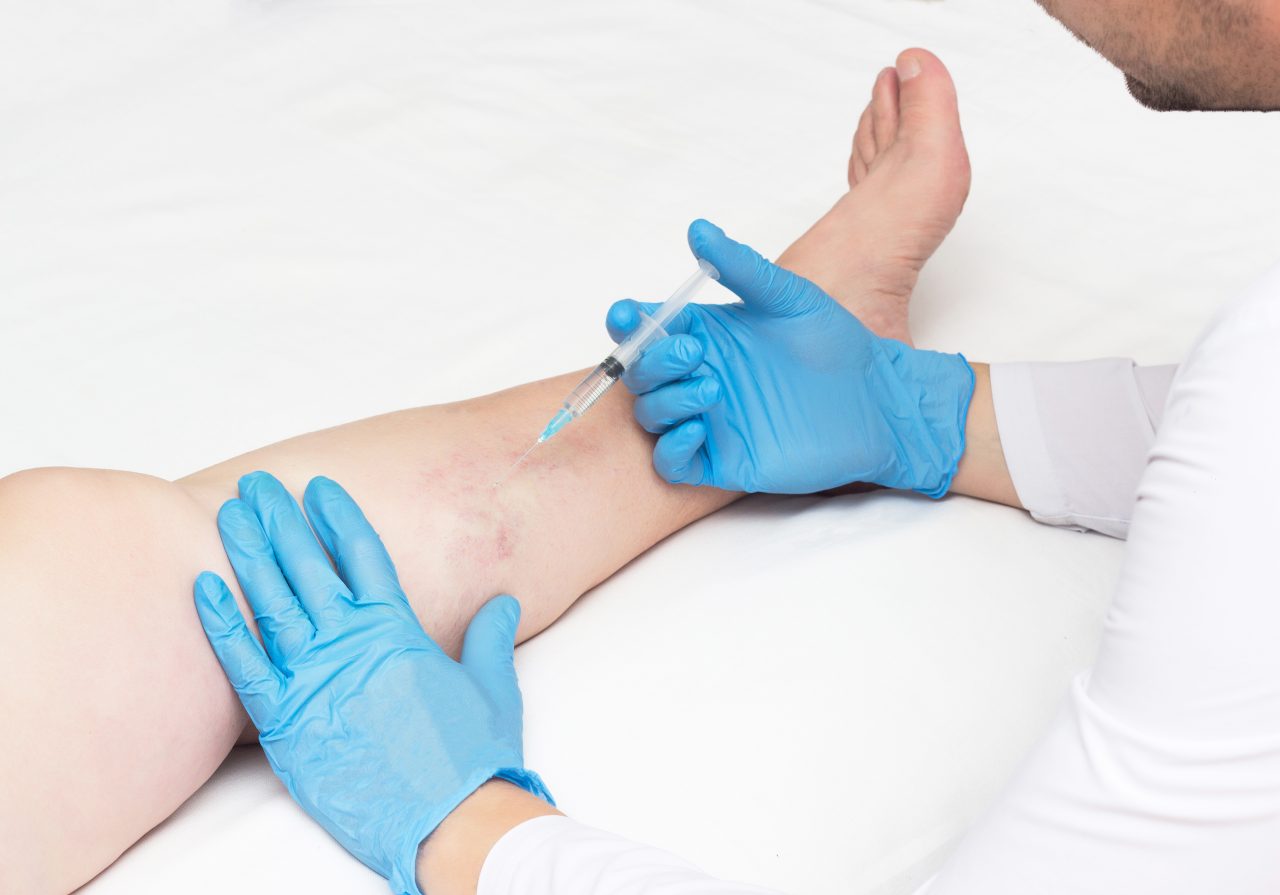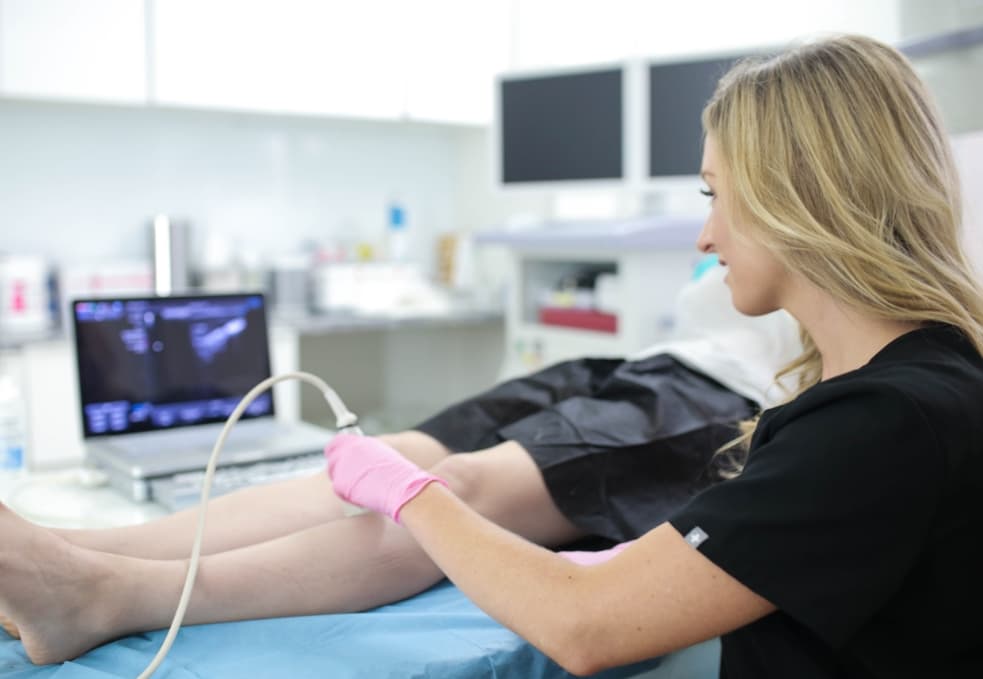Vein issues are more than just cosmetic concerns; they can lead to discomfort, pain, and even health complications if left untreated. Whether you’re dealing with varicose veins, spider veins, or other venous disorders, finding the right treatment is crucial. With advancements in medical technology and a better understanding of venous conditions, there’s no one-size-fits-all solution. Instead, a personalized approach is necessary to address individual needs effectively.
Long Island Vein Treatment is led by board-certified vein doctors who conduct a thorough evaluation to determine the ideal vein treatment for you. Our vein doctors conduct ultrasound tests to determine the root cause of your spider veins and varicose veins. In most cases, varicose veins are symptomatic of chronic venous insufficiency, so it’s important to treat the root cause before removing the visible spider veins and varicose veins.
Long Island Vein Treatment has state-of-the-art medical centers for vein treatment across Long Island, including West Islip, Jericho, Port Jefferson, and Hampton Bays. Please schedule an appointment at your nearest state-of-the-art medical center for vein treatment in Long Island. In this guide, we’ll explore various vein treatments and how they can be tailored to suit you.

Diagnosing the Root Cause of Your Vein Problems
At Long Island Vein Treatment, we understand that spider veins and varicose veins are often symptoms of underlying venous insufficiency. Addressing the root cause is essential for effective treatment and long-term relief from venous issues.
Chronic Venous Insufficiency (CVI) is a condition where the veins fail to adequately return blood from the legs to the heart, leading to blood pooling in the lower extremities. This chronic condition can result from weakened or damaged valves in the veins, obstructed blood flow, or other venous abnormalities. Without proper treatment, CVI can progress and cause more severe symptoms, such as leg swelling, skin changes, and venous ulcers.
Treating spider veins and varicose veins without addressing the underlying venous insufficiency can lead to suboptimal results and the potential recurrence of symptoms. While cosmetic treatments may improve the appearance of surface veins temporarily, they do not address the underlying venous issues that contribute to their development. Moreover, neglecting to treat CVI can result in worsening symptoms and complications over time.
Physical Examination
During your consultation, our vein doctors will evaluate the extent and severity of your venous condition. Our vein doctors will examine the saphenous veins, employing visual inspection and palpation techniques. By inspecting the veins, we can identify visible signs of varicose veins or spider veins and assess their size, color, and distribution. Palpation allows us to detect any tenderness, swelling, or abnormalities in the veins. Furthermore, our vein specialists also look for signs like skin changes, ulcers, or edema.
Symptom Assessment
Our vein doctors will conduct a detailed assessment of your symptoms to gain a comprehensive understanding of your venous health. We will inquire about any discomfort, pain, heaviness, or throbbing sensations you may be experiencing in your legs. Additionally, we will assess for symptoms such as swelling, skin changes, or the development of venous ulcers. By carefully evaluating your symptoms, we identify patterns and correlations that may indicate underlying venous insufficiency and guide further diagnostic evaluations.
Duplex Ultrasound Test
To confirm the presence of venous insufficiency and obtain detailed insights into your venous anatomy, we may recommend a duplex ultrasound test. This imaging technique utilizes sound waves to visualize the blood flow within your veins and assess the functionality of the venous valves. During the duplex ultrasound test, a skilled technician will examine the veins in your legs. By visualizing the blood flow patterns and detecting any abnormalities, such as reflux or obstruction, we can diagnose venous insufficiency.
Treatments for Chronic Venous Insufficiency
Addressing chronic venous insufficiency (CVI) is paramount before treating visible spider veins and varicose veins. While cosmetic treatments may temporarily improve the appearance of surface veins, they do not resolve the underlying venous issues that contribute to their development. By treating CVI first, we can effectively alleviate symptoms, prevent complications, and improve overall leg health.
Endovenous Laser Ablation
Endovenous Laser Ablation (EVLA) is a minimally invasive procedure used to treat underlying venous insufficiency by sealing off problematic veins. During EVLA, a thin laser fiber is inserted into the saphenous vein under ultrasound guidance. The device emits laser energy, causing the vein to collapse and seal shut. Over time, the vein is absorbed by the body, rerouting blood flow to healthier veins. EVLA is highly effective in treating CVI and has a low risk of complications. It offers minimal discomfort and downtime, making it an attractive option for many patients.
Endovenous Radiofrequency Ablation
Endovenous Radiofrequency Ablation (RFA) is another minimally invasive treatment option for CVI. Similar to EVLA, RFA involves inserting a catheter into the saphenous vein under ultrasound guidance. Instead of laser energy, radiofrequency energy is used to heat and seal the vein. Like EVLA, RFA causes the vein to collapse and be reabsorbed by the body over time. RFA is well-tolerated by patients and offers excellent long-term results. It may be preferred in cases where EVLA is not suitable due to anatomical considerations or patient preferences.
VenaSeal
VenaSeal is a relatively newer treatment for CVI that offers a unique approach to vein closure. It involves injecting a medical adhesive (cyanoacrylate) into the saphenous vein through a small catheter. The adhesive seals the vein shut, effectively rerouting blood flow to healthier veins. VenaSeal does not require tumescent anesthesia, making it a more comfortable option for patients. It also offers a shorter recovery time compared to traditional vein treatments. VenaSeal has been shown to be safe and effective in treating CVI, with high patient satisfaction rates.
Treatments for Varicose Veins
Treating varicose veins is essential for relieving symptoms, preventing complications, and improving overall leg health. Varicose veins can cause discomfort, swelling, and aching in the legs, and if left untreated, they may lead to more serious issues such as skin ulcers or blood clots. Whether you have underlying venous insufficiency or superficial varicose veins, we offer the following minimally invasive varicose vein treatments.
ClariVein
ClariVein is a minimally invasive varicose vein treatment that combines mechanical and chemical methods to close off veins. During ClariVein, a catheter with a rotating tip is inserted into the saphenous vein under ultrasound guidance. The catheter delivers a sclerosing agent directly into the vein while simultaneously agitating the vessel walls with the rotating tip. This dual-action approach promotes efficient closure of the vein, leading to improved blood flow and symptom relief. ClariVein offers the advantage of being virtually painless.
Varithena
Varithena is a foam sclerotherapy varicose vein treatment specifically designed to target and close off varicose veins. This FDA-approved foam consists of a sclerosing agent mixed with gas, creating a stable foam that can be injected directly into the affected vein. Varithena effectively displaces blood from the vein, allowing the sclerosing agent to come into direct contact with the vessel walls, leading to vein closure. Over time, the treated vein is absorbed by the body, and blood flow is redirected to healthier veins.
Ambulatory Phlebectomy
Ambulatory phlebectomy is used to remove superficial varicose veins through tiny incisions in the skin. This outpatient varicose vein treatment is performed under local anesthesia, allowing patients to remain awake and comfortable throughout the process. During ambulatory phlebectomy, small segments of the affected veins are removed using special hooks or forceps, leaving behind minimal scarring. This technique is particularly effective for large, tortuous varicose veins that may not respond well to other treatment options.
Treatment for Spider Veins
For individuals solely affected by spider veins without underlying venous insufficiency, we offer sclerotherapy as a direct treatment. However, if you are diagnosed with venous insufficiency in addition to spider veins, we treat the underlying cause first. Once the primary vein treatment, such as endovenous laser ablation or radiofrequency ablation, is completed, we can address the remaining spider veins through targeted spider vein treatment.
Sclerotherapy
Sclerotherapy involves injecting a special solution directly into the spider veins, causing them to collapse and fade over time. This minimally invasive procedure is highly effective in improving the appearance of spider veins and restoring smooth, clear skin. Sclerotherapy is safe and effective and typically requires minimal downtime, allowing you to resume normal activities shortly after treatment. Our vein specialists will customize the procedure to target your specific spider veins, ensuring optimal results and a smoother, more even skin tone.
Your Personalized Vein Treatment in Long Island
Long Island Vein Treatment is committed to providing personalized care tailored to your needs. Our approach begins with a thorough evaluation to accurately diagnose your venous condition. Whether you’re dealing with varicose veins, spider veins, or chronic venous insufficiency, our skilled vein specialists utilize state-of-the-art diagnostic tools to assess your condition.
We develop a customized treatment plan to address your specific concerns and goals. Whether you require minimally invasive procedures such as endovenous laser ablation or sclerotherapy or interventions like ambulatory phlebectomy, we offer advanced treatments to deliver optimal results. With Long Island Vein Treatment, you can trust that you’ll receive expert care and personalized attention every step of the way. For more information, schedule a consultation at your nearest state-of-the-art medical center for vein treatment in Long Island.
